Photos by author except where noted
We all have that one building in our town or response area. We talk about having a fire in it, “the big one,” the one fire that may be a career fire or one that will certainly be a challenge. For the City of Elyria (OH) Fire Department (EFD), on the early evening of February 24, that fire became a reality.
History of the Building
The Washington Towers complex was built in 1899 as the city’s electrical plant. This building was four stories and in 1901 a six-story building was connected to it that originally housed a bicycle seat factory known throughout the United States. (See video of complex below, courtesy of Elyria Police Department Drone.) It measured roughly 73 x 223 feet and was sandwiched between an elevated rail line on the North, two major streets on the East and West sides, and a legacy, block-long, Type III Ordinary Constructed building separated by a 20-foot-wide alley to the South.
RELATED FIREFIGHTER TRAINING
- A ‘Main Street’ Close Call: Lessons from a Small Department’s Downtown Fire
- Main Street Fires: Is Your Department Ready?
- Class: Main Street Optics, Part 1 | Part 2
The building sat vacant for several years as a local developer was in the process of rehabbing and its position in our downtown made it a central figure in any renovation plans. Throughout the last 10 years leading up to the fire, the owner made several attempts to secure and repair openings made by curiosity seekers and vandals. The structure’s proximity to a major elevated rail line and a narrow alley with limited lighting and security made it a challenging endeavor to maintain.
Timeline of Structure: Last 50 Years
1976: The building was occupied with some light commercial and residential occupancies on the fourth floor. A fire occurred on July 22, 1976. The fire was extremely taxing and resulted in a close call with two firefighters running out of air and being trapped on the fourth floor while searching for occupants. These two firefighters were rescued by a Bangor ladder. Seventeen firefighters, all from the Elyria fire department were transported to the hospital because of exertion, smoke, and even a cardiac event.
1977-2010: The lower floors of this massive complex were occupied with several different nightclubs and discotheques which were vogue in the 1970s. These nightclubs stayed in existence until roughly around 2010. The apartments on the fourth floor remained occupied as well until this period. Floors and sections of the complex that were vacant/unused were filled with everything from old paneling, office materials, paint—just about everything imaginable.
2015-2021: The new owner purchased the complex and was working with city officials in renovating this building as well as several others in downtown Elyria.

-
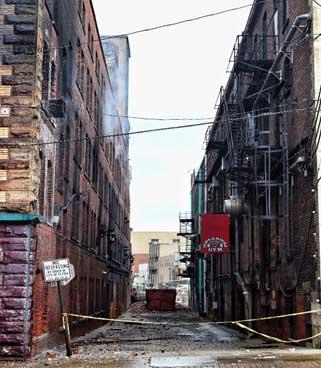
Narrow alleyway between fire building (left) and legacy Type III exposures (right). -
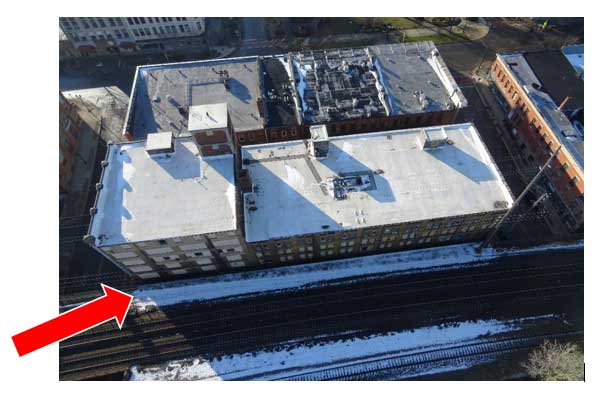
North side of complex was a challenge as it limited fire crews because of rail line and high-tension power lines, both of which had to be shut down immediately. Photo by EPD drone
About the Elyria (OH) Fire Department
The City of Elyria Fire Department current staffs three engines and one truck with a shift commander in a command vehicle for a total daily on duty strength of 14 members. The department protects roughly 22 square miles with 53,500 residents in a mostly urban setting. It has an average run volume of 4,500 calls a year.
On February 24 at 1954 hours, the Elyria Fire Department was dispatched for “smoke in the area” of the Powerhouse Gym located at 425 Broad Street in the downtown section of the city. Upon arrival, Acting Assistant Chief (AAC) Mark Slack (Chief 3) reported a working fire on the third floor of the Washington Towers building, which is located behind 425 Broad Street. AAC Slack was faced with a rapidly extending fire in one of the more challenging buildings in the city to fight a fire in. Over the next six hours all but one fire department from Lorain County would end up responding apparatus and assisting in controlling one of the largest fires in the city’s history.
First 911 call from citizen (click to play)
Lorain County Dispatch was beginning to receive calls indicating a fire at the downtown area and began the dispatch of units. Captain Mark Slack was acting in the role of shift commander and arrived in the shift commander’s vehicle (Chief 3) at 1956 hours and found heavy fire in the Washington Towers building located at 100 Washington Avenue.
Three engines (1, 3, and 4) and a truck company (Tower 8) arrived and set up for initial operations with the hope of knocking down the heavy fire conditions visible on the Kerstetter Street side of the complex.
AAC Slack ordered the use of Engine 1’s deck gun and advised Tower 8 to set up on the Kerstetter
side of the building and prepare aerial for operations, he advised them to take a flanking position. Initial Audio, Silence Truncated (click to play) Arrival
AAC Slack (Chief 3) advised all EFD companies to switch to our regular assigned tactical fireground channel (TAC 11) and ordered a “High Hazard” MABAS (Mutual Aid Box Alarm System) call, which would bring two engines and two trucks on each alarm. Slack also ordered a recall of off-duty members and a command officer page which would go to all captains and assistant chiefs on the fire department.
Around this same time, off duty Assistant Fire Chief Jamie Norris, who was to report back on duty as the shift commander at 2030 hours saw, the fire as he was driving in and went right to the scene, arriving at the same time at the command post as recalled Assistant Chief Joseph Pronesti.
Assistant Chiefs Pronesti and Norris discussed the current apparatus assignments made by Slack and began to form an incident action plan: Norris would take command of the fire and
Pronesti would assist with coordinating the mutual aid and resources being called over the main dispatch channel. Captain Slack was then re-assigned to the Kerstetter side of the structure to supervise operations on that side of the building.
Elyria Engine 1 was positioned on the Kerstetter side and placed their deck gun into service as originally requested, Engine 1 set up on a hydrant on Kerstetter near Merchants Alley and laid a supply line to Tower 8. Engine 3 laid two 2 ½-inch handlines and placed them into service on the Kerstetter Side of the complex.
Elyria Tower 8’s aerial had trouble positioning due to the incline of the street and the ornamental lights that are strung between 425 and 501 Broad Street. These lights while low voltage caused an issue and were not as easy to break away as originally thought of when they were placed on the buildings in the early 2000s.
Elyria Engine 4 set up at Washington and Broad and gave a report on that side of the complex. The Engine 4 crew was ordered to establish water supply for the large master streams when mutual aid companies arrived and were placed on that side of the complex.
Defensive operations continued and the fire was placed under control around 2330 hours. Crews remained on scene throughout the next day and were called back several times as the fire flared up repeatedly for over a week.
Water Supply and Shuttle Operations
With a fire of this magnitude, water supply will always be an issue. The original arriving companies established adequate water as the hydrants in the downtown area were all over 800 gpm. The biggest need was when command (Norris) became concerned about exposure protection and crews had to establish lines in the Robinson Building and old Powerhouse Gym.
A good rule of thumb during large fire events is to be cautious in not hooking up to hydrants that are all fed from the same water main. Command (Norris) was very astute to this issue and called for the county water shuttle to establish a continuous water supply.
Assistant Chief William Gall from the EFD was assigned as the water supply officer and worked with mutual aid water shuttle crews in establishing fill sites and portable pond areas near the fire scene.
When the call for the water shuttle was made, most of the remaining county fire departments responded to provide an engine to establish pumping from the portable ponds and tankers to fill and dump at the ponds.
Another order undertaken was the Elyria Water Pumping Plant boosting the water pressure in the downtown area, thus increasing the hydrant pressures of those already being used.
Communications
Communications is the backbone of any emergency incident. The initial crews followed EFD standard procedure by switching to our assigned fireground radio channel. Mutual aid crews on the first three alarms via the MABAS switched to this channel and for the most part communications were not a major issue at this event. When the incident began to escalate, two more fireground channels were assigned, one for the crews operating in the exposures (Robinson and Powerhouse buildings) and one for water shuttle operations.
Another item of note was the use of a county emergency management channel that Command (Norris) used with Assistant Chief Pronesti in getting information without tying up any of the fireground channels in use.
Use of Drones
If there is one piece of technology that is in this writer’s opinion that will be a must have in future events it is the use of unmanned flying aircraft aka drones. The Elyria Police Department, in conjunction with the Water Pumping Division purchased two drones in 2019. As of this report, 11 police officers have been trained to operate and the pictures/video reconnaissance they can bring to an incident is remarkable and is a must have.
The drones currently employed by Elyria police also use infrared technology which can help detect heat signatures. While probably utilized for detecting humans, being able to detect heat from the fire is of great help and can indicate to an incident commander where the fire is, where it is going, and the impact elevated streams are having,. During this event the drone indicated that streams on the north side of the building were not having much, if any, effect on the fire.
Know Your History and Pay Attention
Every fire department with some “age” to it will have someone that understands its history of emergencies and fires. While this may not be at the top of your to-do, this it is important to pay attention to when you hear the stories or when you go through that old box of records or photos of past fires. We have lost the art of listening to the “war stories” as many of us are too busy looking at our phones and pads.
On July 22, 1976, the Elyria Fire Department responded to a fire in the Washington Towers building that originated at the base of an empty shaft, fire, heat and smoke spread throughout the building, which at the time had 21 apartments occupied on the fourth floor. Firefighters performed numerous rescues and at the end of the day 17 firefighters were taken to the hospital for smoke and heat exhaustion. Think about that in today’s service. When was the last time you read or were part of an operation that felled so many members? Now the use (or lack thereof) of self-contained breathing apparatus played a part, but it’s important to note the difficulties the mammoth building presented to commanders that day and apply it to today’s issues of things like staffing reductions.
In 1976, the initial response was 22 members staffing five engines, a snorkel, rescue, and command vehicle. At the 2021 fire, the EFD’s response was 14 members staffing three engines, a truck, and command vehicle.
After the fire in 1976, the building continued to be used as commercial and residential mixed-use and was always on our “radar” for a potential incident. The building was left vacant around 2010 and the owner attempted to secure and maintain it. The building’s sheer size, proximity to the railroad, and curious urban adventurers making entry made it almost impossible to do. Another important use of the drones is viewing high hazard buildings and concerns prior to an event taking place. In late 2019, Assistant Chief Pronesti met with the EPD drone operators and a review of the downtown, including the view of the Washington Towers complex. The use of drones in preplanning cannot be overstated; it is a must-have item in the fire service.
In early 2020, the local newspaper ran an article after streets were closed in Elyria’s downtown due to façade issues, the freezing and thawing cycle of hundreds of years needs to be considered as you preplan your Main Street.
Bricks start to bow out of some downtown Elyria buildings | Chronicle Telegram
EFD Crews placed Tower up to inspect Southeast wall in 2019:
Overview of complex taken by Elyria Police Drone during preplan of downtown buildings:
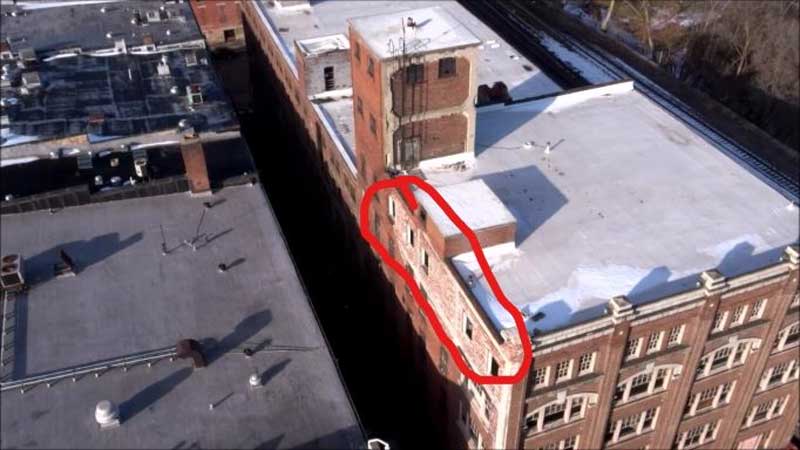
-

Having sector officers is a must to evaluate the use of master streams and collapse potential. If streams are not effective, shut them down or reposition. You cannot afford to waste a single gallon of water at these large events. Bruce Bishop/Elyria Chronicle-Telegram -
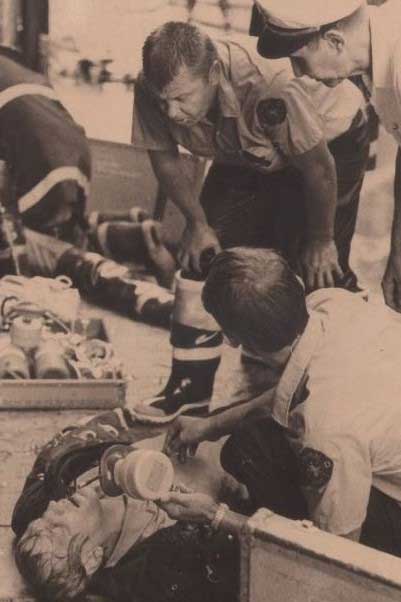
Seventeen firefighters were felled in the 1976 fire in this same structure. The size of your Main Street structures is one item to be considered. The member shown was rescued by the gentlemen checking on him from the fourth floor of the complex after his air supply was exhausted and he became lost leading a group of occupants out. Photo: Chronicle Telegram Elyria Archives by Mr. Kim Tonry.
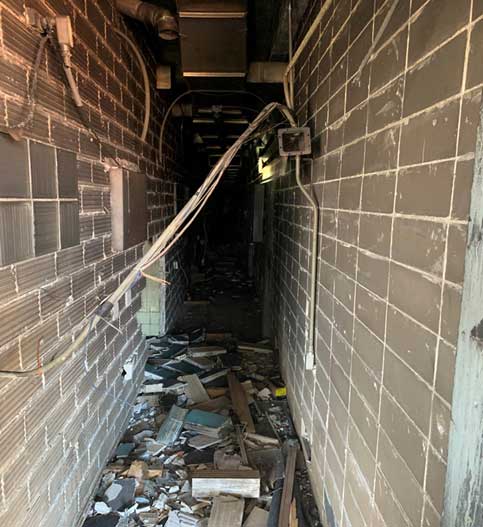
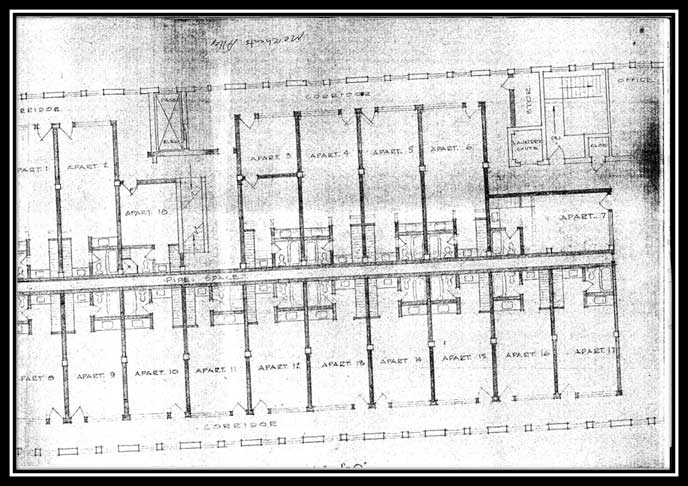
-
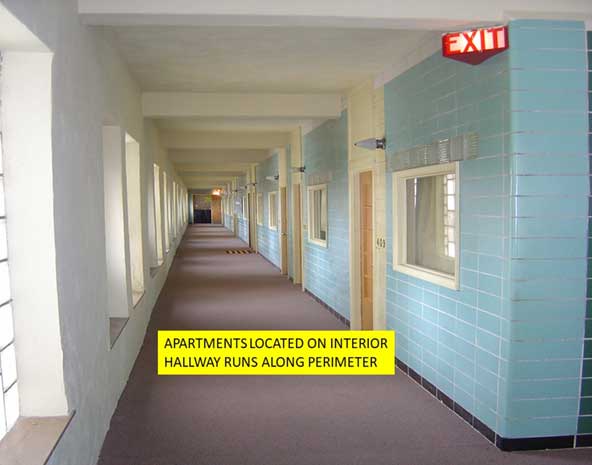
Fourth-floor apartments were built as an inner core, limiting stream reach into the apartments themselves, which were loaded with debris. -
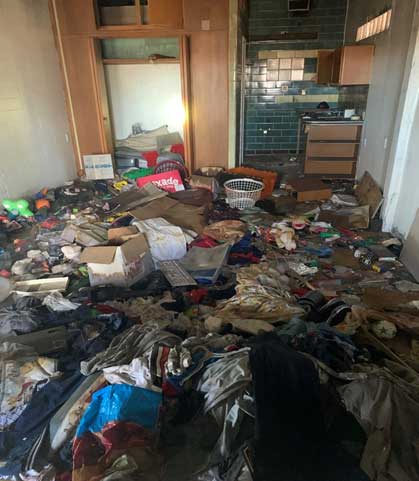
Fourth-floor apartments were filled with items, creating a heavy fire load. -
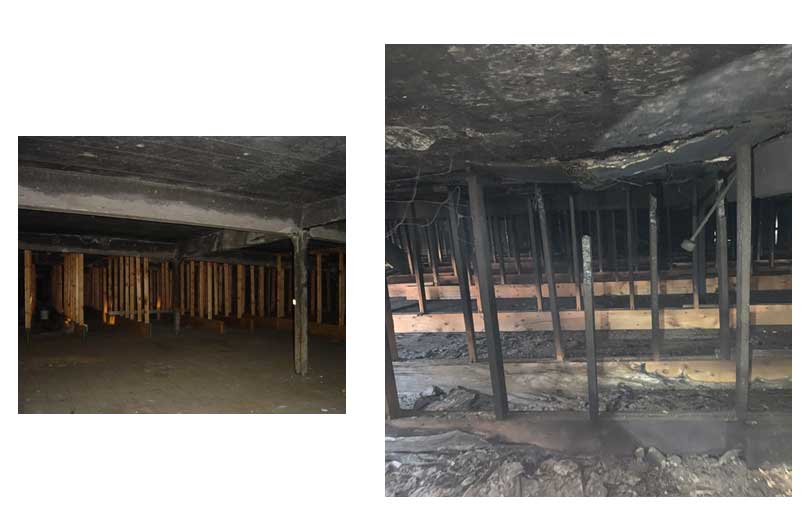
A concrete reinforcement of the roof with 2x4s (left) was well known to EFD commanders prior to the fire. Here is a look at them after the 2021 fire.
-

Collapse zone setup is essential at Main Street fires. Photo by Bruce Bishop. -
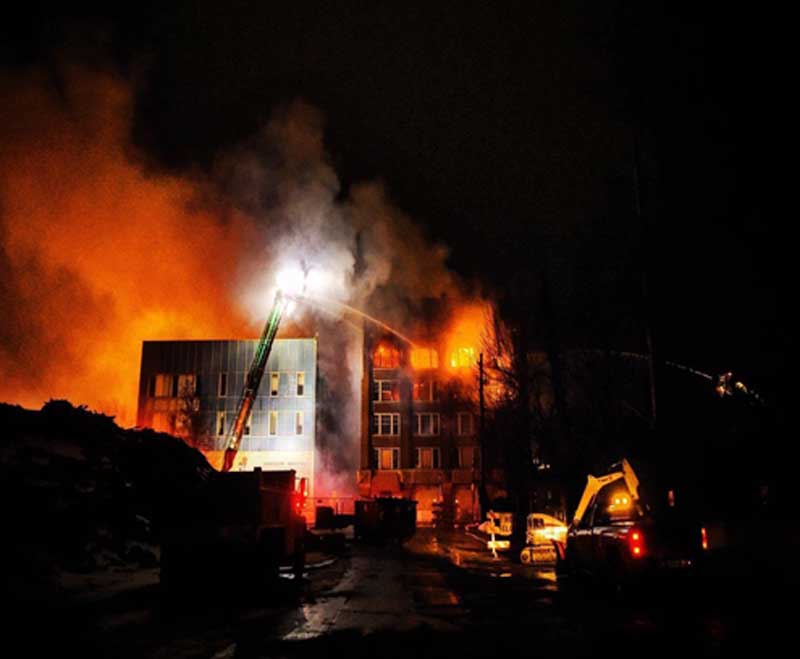
Crews were met with a difficult exposure issue with a four-story Type III less than 20 feet away from the main fire building. Photo: Bruce Bishop/Chronicle-Telegram -

Hoselines were stretched into the exposure building (above) and then played into the windows across the alley. Photo: Terry Costigan/TMC News Elyria -
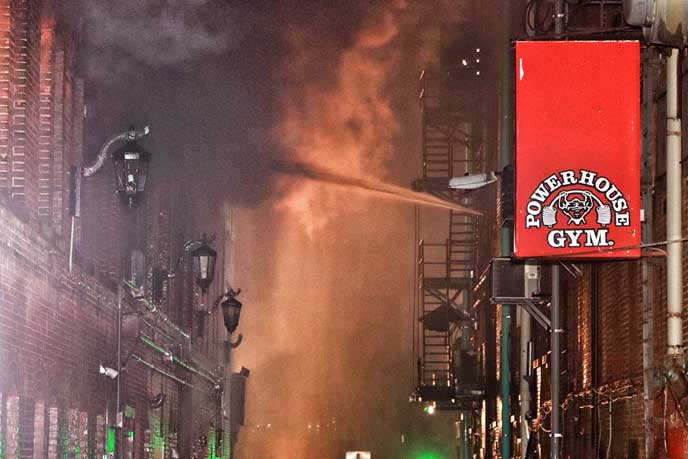
Exposure protection was achieved by handlines in building across narrow alley.
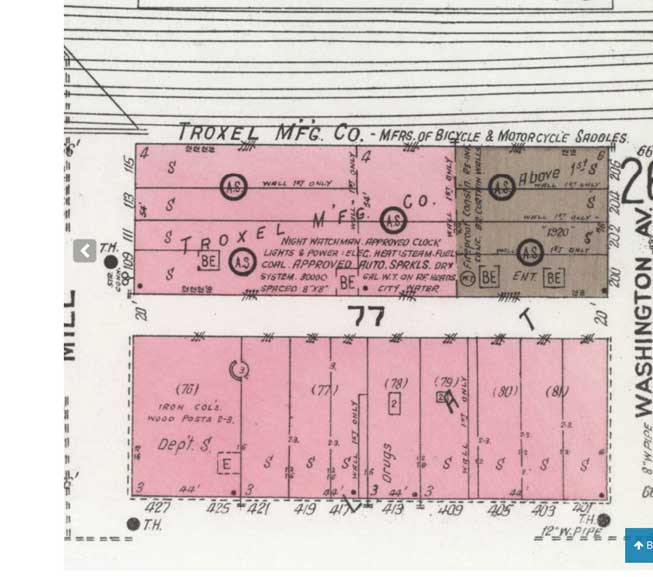
Reviewing Sanborn Maps prior to your next Main Street fire can give you recon on your legacy buildings. Here is a Sanborn map from the early 1900s showing the location of elevator shafts in the fire building. This knowledge assisted in fire attack and command decisions early in the event.
Lessons
However you want to look at it, good or bad, the EFD has had its share of large emergency events, from old mill fires to hazardous material incidents necessitating the evacuation of thousands of residents. The key I would like to share to you reading this is to review your past events regardless of if you were involved or not. Also, use your imagination. I had “experienced” in my head many different types of fires in this structure for most of my career. Heavy smoke, no fire visible, incipient fires necessitating crews to find the source, and fires where we had what we encountered on arrival February 24, 2021. Always be thinking and sizing up buildings in your head.

Many older downtowns think that lighting is the key to revitalizing their Main Street. I am not here to judge that, what I am here to recommend however is the need to understand how these decorative string lighting setups can impact your aerial operations. The structure involved had several rows of lights stretched on its west side connected to a building across the street. When the subject of these lights were brought up, the EFD were always told that our aerial could simply snap them. That was NOT the case. Our truck company had a large delay in attempting to go airborne for elevated streams. We were lucky that’s all we had a delay on with these luminaries; had we had a rescue, the delay could’ve been tragic. If you have this situation in your downtown district, understand how to disconnect and remove them. Better yet, advocate against their use at all.
Collapse zones are not an everyday thing. Smaller fire departments like mine are not used to setting them up, but when you do have a larger building fire and collapse is a concern, these zones must be established and sector bosses need to make sure members operating adhere to these zones. Small handlines should be shut down and water supplied to master streams.
In the book, 3000 Degrees written by Sean Flynn on the Worcester Cold Storage tragedy that claimed the lives of six firefighters on December 3, 1999, Deputy Chief Mike McNamee of the Worcester (MA) Fire Department describes passing the building while driving with his wife prior to the fire event and telling her that the building (cold storage building) “scares the blank out of me.” That quote has stuck with me, and I encourage you to find your Worcester Cold Storage buildings and other Main Street structures. Research them, get to understand them inside and out. Hopefully you’ll never have to utilize the knowledge, but you will be able to both mentor future firefighters on the need to understand your specific hazardous buildings and create a culture of preparedness.
Although this Main Street fire was very destructive, it was a success as it proved advanced knowledge and constant study of your buildings will keep your members safe and protect those exposure structures threatened by a fire.
This article is dedicated to retired Elyria Fire Department Captain Raymond H. Pileski, whose picture is in this article as he was checking on a member be personally saved from the fourth floor at the 1976 fire in the Washington Tower Complex, Captain Pileski along with only four others raised a 45-foot Bangor ladder in the alley adjacent to the complex described in the article. Ray served the department from 1954 to 1982 and recently passed away at the age of 93.
Joseph Pronesti is a 33-year veteran of the city of Elyria (OH) Fire Department. He is a frequent contributor to Fire Engineering and serves as the chief of department. He will be presenting the preconference workshop Main Street Fires 2022 at FDIC International in April of 2022.

